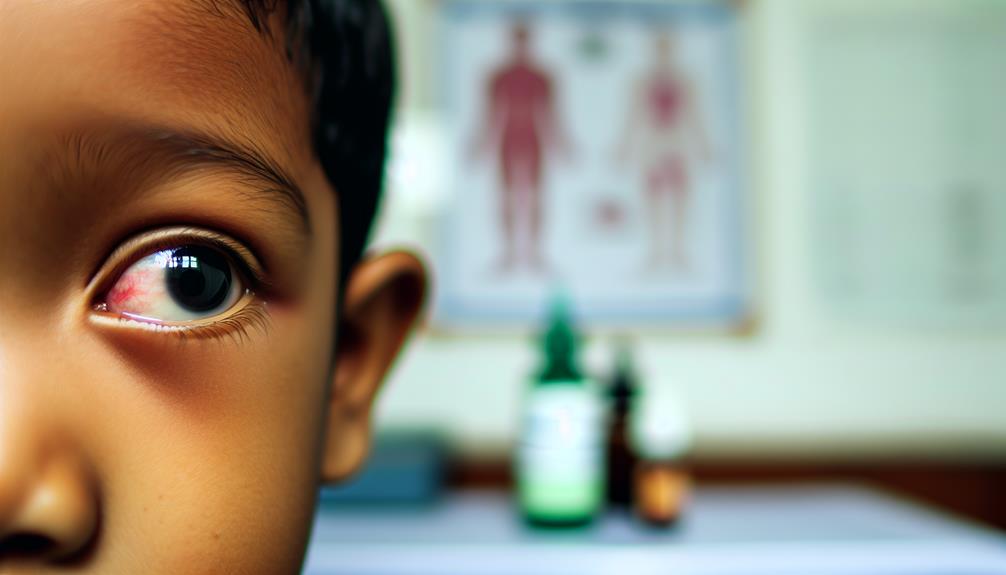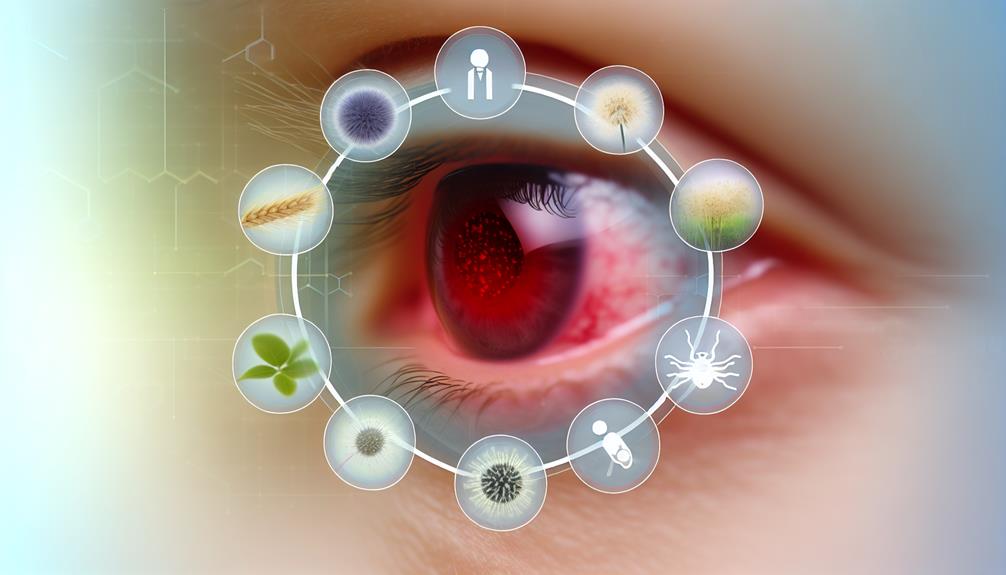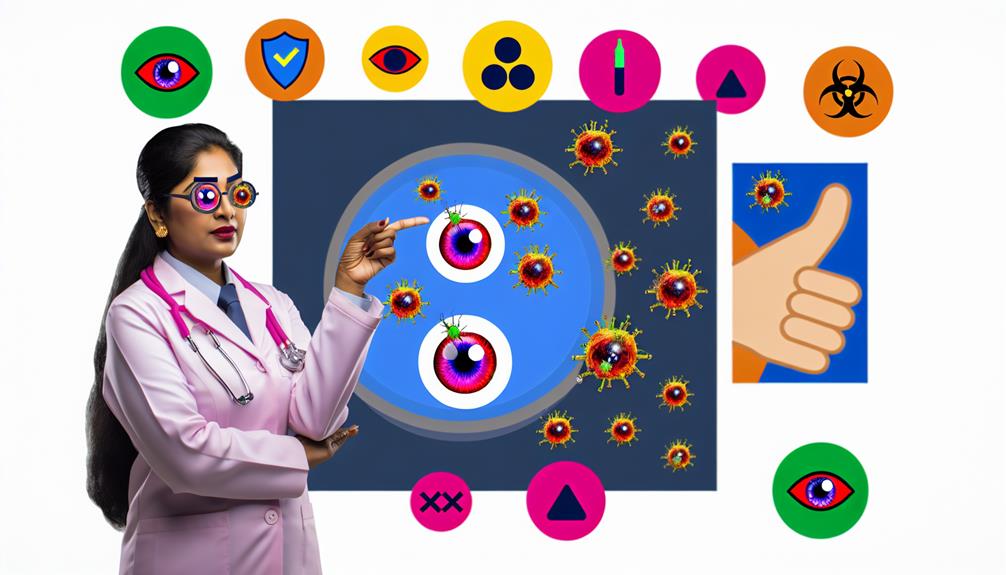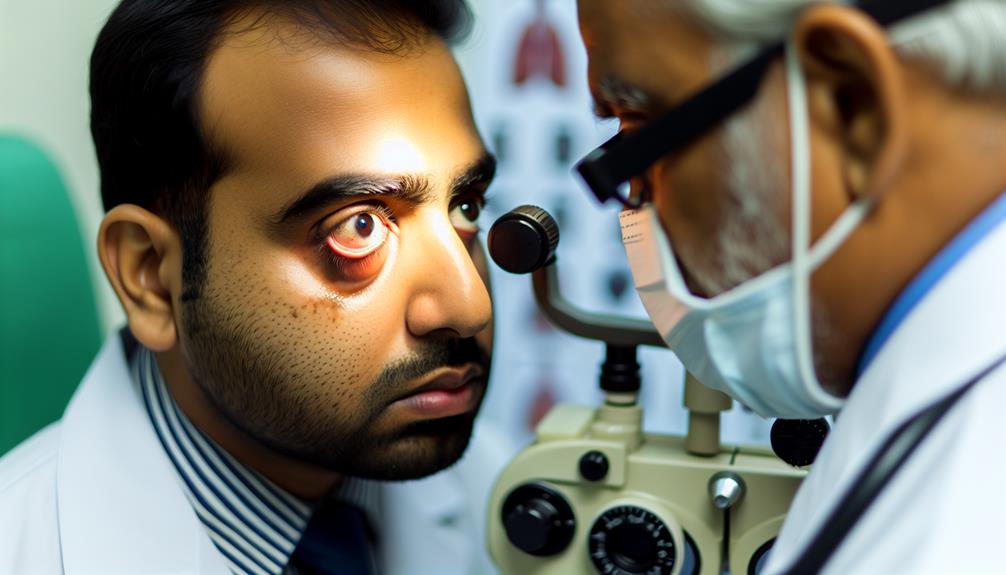Doctors want patients to understand that pink eye, or conjunctivitis, is an inflammation of the conjunctiva caused by viral, bacterial, or allergic factors. Symptoms typically include redness, swelling, and varying discharge. Treatment options differ by type; viral cases often resolve independently, while bacterial infections may require antibiotic eye drops. Allergic conjunctivitis can be managed with antihistamines and avoidance of allergens. Emphasizing good hygiene practices is vital to prevent transmission, particularly in communal settings. Recognizing when to consult a physician guarantees timely intervention and effective management of this common condition, revealing essential insights on symptoms and treatment approaches.
Key Takeaways
- Pink eye can be viral, bacterial, or allergic; understanding the type helps in choosing the right treatment.
- Seek medical attention for severe symptoms, vision changes, or persistent discomfort to avoid complications.
- Viral conjunctivitis is self-limiting; antibiotics are ineffective and not needed for this type.
- Maintain good hygiene, like hand washing and avoiding eye contact, to reduce transmission risks.
- Misconceptions exist; not all pink eye types are contagious, and treatment varies based on the underlying cause.
Understanding Pink Eye

Pink eye, clinically known as conjunctivitis, is an inflammation of the conjunctiva, the thin membrane that covers the white part of the eye and the inner eyelids. This condition can arise from various etiologies, including viral, bacterial, allergic, and irritative factors. Each subtype of conjunctivitis necessitates a tailored approach to treatment and management. Importantly, soothing remedies such as herbal teas can sometimes provide comfort to those experiencing stress from symptoms, promoting overall relaxation and well-being, similar to the effects of unwinding with Sleepytime tea.
Diagnosis methods for pink eye typically begin with a thorough patient history and ophthalmic examination. Healthcare professionals may assess symptoms, such as redness, discharge, and discomfort, to determine the underlying cause. In some cases, additional diagnostic tests, such as conjunctival swabs or cultures, may be employed to identify specific pathogens, particularly in bacterial conjunctivitis. Allergic conjunctivitis may require identification of allergens through skin tests or patient-reported exposure history.
Understanding pink eye is essential for effective management and prevention of transmission, particularly in communal environments. By recognizing the different types of conjunctivitis and the appropriate diagnosis methods, individuals can better navigate their symptoms and seek timely medical intervention, fostering a sense of community and shared knowledge in addressing this common ocular condition.
Common Symptoms
Conjunctivitis presents with a range of symptoms that can vary depending on the underlying cause. Common symptoms include redness of the eye, which may be accompanied by swelling of the conjunctiva, a clear membrane that covers the white part of the eye. Patients often report eye discomfort, which can manifest as a gritty or burning sensation. This discomfort can affect individuals differently, much like how exercise frequency varies among different people based on their unique needs and goals. Discharge from the eyes is also prevalent, with variations in color and consistency depending on whether the conjunctivitis is bacterial, viral, or allergic in nature.
Symptom duration can differ notably; viral conjunctivitis symptoms may last from a few days to two weeks, while bacterial forms often resolve within a week with appropriate treatment. Allergic conjunctivitis can persist as long as the allergen is present. Patients may also experience increased tearing, light sensitivity, and crusting of the eyelids upon waking, particularly in cases of bacterial conjunctivitis.
Understanding these common symptoms is essential for timely diagnosis and management. If you are experiencing any combination of these symptoms, consulting a healthcare professional can provide clarity and prompt appropriate treatment options.
Causes of Pink Eye

The causes of pink eye, or conjunctivitis, can be categorized into three primary types: viral infections, bacterial infections, and allergic reactions. Understanding the nuances of these causes is essential, as text messaging dynamics can sometimes lead to misunderstandings in patient-doctor communication. Viral conjunctivitis is often associated with common colds, while bacterial conjunctivitis is typically caused by specific bacterial pathogens. Allergic conjunctivitis arises from exposure to allergens, triggering inflammatory responses in the eye.
Viral Infections Overview
Viral infections represent a significant cause of conjunctivitis, commonly known as pink eye. The most prevalent viruses responsible for this condition include adenoviruses, which account for a large proportion of cases. Understanding the mechanisms of viral transmission is essential in mitigating outbreaks, especially in communal settings such as schools and daycare centers.
The severity of viral conjunctivitis can vary based on individual immunity factors. Those with compromised immune systems may experience more severe symptoms and prolonged recovery times.
To further elucidate the types of viral infections contributing to pink eye, the following table summarizes key information:
| Virus Type | Common Symptoms | Transmission Method |
|---|---|---|
| Adenovirus | Redness, tearing, discharge | Direct contact, respiratory droplets |
| Herpes Simplex | Painful sores, sensitivity to light | Direct contact with sores |
| Cytomegalovirus | Mild redness, discharge | Close personal contact |
| Enterovirus | Red, watery eyes | Contact with contaminated surfaces |
Awareness of these factors can empower patients and aid in effective management of viral conjunctivitis.
Bacterial Infections Explained
Bacterial infections are a prominent cause of pink eye, often resulting in more pronounced symptoms compared to their viral counterparts. The condition, known medically as conjunctivitis, occurs when harmful bacteria invade the conjunctiva, leading to inflammation and discomfort. Common bacterial pathogens include Staphylococcus aureus, Streptococcus pneumoniae, and Haemophilus influenzae.
Bacterial transmission typically occurs through direct contact with infected individuals or contaminated surfaces. This highlights the significance of hygiene practices, such as regular handwashing and avoiding sharing personal items, in preventing the spread of infection. Symptoms may include redness, excessive tearing, and a purulent discharge, which can greatly impact daily activities and overall quality of life.
It is essential to address bacterial conjunctivitis promptly, as untreated infections can lead to complications. The rise of antibiotic resistance further complicates treatment, making it critical for healthcare providers to prescribe appropriate antibiotics based on susceptibility patterns. Patients are encouraged to complete prescribed antibiotic courses to effectively eliminate the infection and minimize the risk of developing resistant bacterial strains. Understanding these factors fosters a supportive environment where patients can actively engage in their healthcare decisions.
Allergic Reactions Triggers
In addition to bacterial infections, allergic reactions represent a significant cause of pink eye, or conjunctivitis. Allergic conjunctivitis occurs when the eyes react to specific allergy triggers, leading to inflammation and discomfort. Common triggers include pollen from trees, grasses, and weeds, as well as mold spores and pet dander. These environmental factors can provoke the immune system, causing the release of histamines that result in classic symptoms such as redness, itching, and tearing.
Individuals may also experience allergic reactions to substances such as dust mites, smoke, or certain chemicals in cosmetics and skincare products. It is essential for patients to identify and avoid known allergy triggers to manage symptoms effectively. In cases of persistent allergic conjunctivitis, healthcare providers may recommend antihistamines, either in oral or topical form, to alleviate discomfort.
Recognizing the relationship between allergy triggers and pink eye can empower individuals to seek appropriate treatment. By understanding the interplay between environmental factors and allergic reactions, patients can take proactive steps towards reducing their exposure, ultimately improving their ocular health and overall well-being.
Types of Conjunctivitis
Conjunctivitis, commonly known as pink eye, can be classified into several types, with viral and bacterial conjunctivitis being the most prevalent. Viral conjunctivitis is typically characterized by a watery discharge and is often associated with upper respiratory infections, while bacterial conjunctivitis presents with a thicker, purulent discharge and may require antibiotic treatment. It is crucial to recognize that the severity and duration of symptoms can vary greatly between these types, influencing the treatment approach. Understanding the distinctions between these types is essential for accurate diagnosis and effective management. Additionally, the caloric content of over easy eggs can provide insights into dietary considerations that may affect overall health.
Viral Conjunctivitis Overview
Viral conjunctivitis, commonly referred to as pink eye, is an inflammation of the conjunctiva caused by viral infections, most frequently associated with adenoviruses. This condition can spread easily through viral transmission, particularly in crowded environments such as schools and daycare centers. Symptoms typically include redness, watering, and a gritty sensation in the eye, which may also be accompanied by a clear or watery discharge.
In contrast to bacterial conjunctivitis, viral conjunctivitis is generally self-limiting and typically resolves within one to two weeks without specific medical treatment. However, supportive care is essential to alleviate discomfort. Patients are advised to maintain proper eye hygiene, which includes frequent handwashing, avoiding touching the eyes, and using separate towels or linens to prevent the spread of the virus to others.
It is important to recognize the symptoms early and practice preventive measures to minimize transmission. Understanding viral conjunctivitis is vital for fostering a sense of community awareness and promoting health practices that safeguard both individual and collective well-being. Timely intervention and adherence to hygiene protocols can greatly reduce the incidence of this common eye condition.
Bacterial Conjunctivitis Characteristics
While viral conjunctivitis is often self-limiting, bacterial conjunctivitis presents a distinct set of characteristics that necessitate prompt recognition and treatment. This type of conjunctivitis is primarily caused by bacteria such as Staphylococcus aureus and Streptococcus pneumoniae. Symptoms typically include redness, swelling, and discharge, which may be purulent in nature. Patients often experience discomfort and a gritty sensation in the affected eye.
Bacterial transmission occurs through direct contact with infected secretions or contaminated surfaces, underscoring the importance of proper eye hygiene. Individuals should avoid touching their eyes, sharing personal items, and ensuring frequent handwashing to minimize the risk of spreading the infection.
Diagnosis is usually clinical, with healthcare providers evaluating symptoms and conducting a thorough examination. Treatment often involves antibiotic eye drops or ointments tailored to the specific bacterial strain. Prompt intervention is essential, as untreated bacterial conjunctivitis can lead to complications such as corneal ulcers or vision impairment.
When to See a Doctor

Recognizing when to seek medical attention for pink eye is vital for effective treatment and preventing complications. While mild cases of conjunctivitis may resolve on their own, specific symptoms necessitate a consultation with a healthcare provider. If you experience severe redness, swelling, or discharge that worsens over time, these may indicate a bacterial or viral infection requiring further evaluation. In today's world, where many people work remotely, it's important to know that some flexible job options can allow you to seek medical care without affecting your work-life balance.
Additionally, if your symptoms are accompanied by vision changes, significant pain, or sensitivity to light, these warrant immediate medical attention. The diagnosis process typically involves a thorough examination of the eyes and may include a review of your medical history and symptoms. Understanding the treatment timeline is critical; delayed intervention can lead to prolonged discomfort and potential complications.
Individuals with pre-existing eye conditions or weakened immune systems should also seek prompt medical advice, as they are at higher risk for complications. Remember, timely consultation with a healthcare professional not only aids in accurate diagnosis but also enhances the effectiveness of treatment, fostering a sense of community and support during your recovery journey.
Effective Treatment Options
Effective treatment options for pink eye vary depending on the underlying cause of the condition, with three primary categories: viral, bacterial, and allergic conjunctivitis. For viral conjunctivitis, which is the most common type, treatment primarily focuses on symptom relief, as antibiotics are ineffective against viruses. It is vital to maintain good eye hygiene, including regular hand washing and avoiding touching the eyes, to prevent the spread of the infection.
In cases of bacterial conjunctivitis, antibiotic use is warranted. Topical antibiotic drops or ointments are typically prescribed, and most patients experience symptom resolution within a few days. Adhering to prescribed medication regimens and practicing proper eye hygiene can greatly enhance recovery and reduce transmission risk.
Allergic conjunctivitis is best managed through the use of antihistamines or anti-inflammatory eye drops. Additionally, identifying and avoiding allergens can help alleviate symptoms. Regardless of the type of pink eye, fostering an environment of good eye hygiene is essential. Patients are encouraged to consult their healthcare provider for tailored advice and treatment options, ensuring a supportive approach to their eye health.
Home Remedies and Care

In addition to conventional treatments, home remedies can provide supportive care for individuals experiencing pink eye. While these remedies should not replace medical advice, they can help alleviate discomfort and promote healing.
One effective approach is the use of soothing compresses. Applying a clean, damp cloth to the affected eye can help reduce inflammation and provide relief from itching or burning sensations. It is vital to guarantee that the compress is at a comfortable temperature, as extreme heat or cold can exacerbate symptoms.
Natural remedies may also play a role in managing pink eye symptoms. For instance, chamomile tea bags, when cooled and placed over the eyes, can offer anti-inflammatory properties and enhance comfort. Additionally, a saline solution can be utilized for rinsing the eyes, helping to flush away irritants and reduce redness.
It is essential to maintain good hygiene during treatment to prevent further irritation or infection. Regular handwashing and avoiding touching the eyes are fundamental practices. While home remedies can be beneficial, consultation with a healthcare professional remains paramount for proper diagnosis and treatment guidance.
Prevention Tips
Preventing pink eye, or conjunctivitis, requires a multifaceted approach focused on hygiene and environmental awareness. Implementing effective hygiene practices is essential in reducing the risk of transmission, particularly in communal settings. Regular hand washing with soap and water, especially after touching the face or eyes, is a fundamental step. When soap and water are unavailable, an alcohol-based hand sanitizer can be a suitable alternative.
Additionally, avoid touching or rubbing the eyes, as this can introduce irritants and pathogens. It is also advisable to refrain from sharing personal items such as towels, cosmetics, and eye care products, which can harbor bacteria and viruses.
Maintaining a clean environment is equally important. Regularly disinfect surfaces that are frequently touched, such as doorknobs, light switches, and shared electronics. For those wearing contact lenses, adhering to proper eye care guidelines, such as cleaning and storing lenses correctly, is vital in preventing infection.
Myths and Misconceptions

What common myths surround pink eye, and how do they impact public understanding of this condition? The prevalence of misconceptions regarding pink eye, or conjunctivitis, can lead to unnecessary anxiety and mismanagement of the illness. Myth debunking is essential for fostering a better understanding of this common ocular condition.
- Pink eye is always contagious: While viral and bacterial conjunctivitis can be contagious, allergic conjunctivitis is not.
- You can catch pink eye from swimming pools: Swimming pools can harbor bacteria, but proper chlorination considerably reduces this risk.
- Antibiotics are always necessary: Antibiotics are only effective for bacterial conjunctivitis; viral infections often resolve without treatment.
- It is primarily a childhood illness: Pink eye can affect individuals of all ages, not just children.
Misconception clarification is important for promoting informed decisions regarding treatment and prevention. By addressing these myths, patients can seek appropriate care and take proactive measures to minimize the risk of infection, ultimately fostering a sense of belonging to a well-informed community. Understanding the facts about pink eye is essential for effective management and reducing stigma associated with the condition.
Frequently Asked Questions
Can Pink Eye Be Contagious Without Symptoms Present?
Pink eye, or conjunctivitis, can indeed be contagious even in the absence of symptoms. This phenomenon, known as asymptomatic transmission, highlights the importance of understanding contagious periods associated with the condition. Individuals may unknowingly spread the infection to others, particularly in communal settings. Consequently, it is essential for individuals to practice good hygiene and take preventive measures, even when they do not exhibit visible signs of infection, to mitigate potential spread.
How Long Is Pink Eye Contagious After Starting Treatment?
The duration of contagiousness following the initiation of pink eye treatment largely depends on the underlying cause. For bacterial conjunctivitis, individuals are typically considered non-contagious after 24 to 48 hours of appropriate antibiotic treatment. In contrast, viral conjunctivitis may remain contagious as long as symptoms persist. Hence, understanding pink eye transmission dynamics is essential for effective management and preventing further spread, emphasizing the importance of adherence to prescribed treatment protocols.
Is There a Specific Diet That Helps With Recovery?
While no specific diet is proven to expedite recovery from pink eye, certain nutrition tips can support overall eye health. Incorporating recovery foods rich in vitamins A, C, and E, along with omega-3 fatty acids, may contribute to immune function and reduce inflammation. Foods such as leafy greens, citrus fruits, nuts, and fatty fish can be beneficial. Staying hydrated is also essential in promoting healing and maintaining ideal bodily function during recovery.
Can Wearing Contact Lenses Cause Pink Eye?
Wearing contact lenses can indeed contribute to the development of pink eye, or conjunctivitis, particularly if proper contact lens hygiene is not maintained. Inadequate cleaning, prolonged wear, or exposure to contaminated environments can increase the risk of eye infections. To mitigate this risk, individuals should prioritize eye infection prevention by adhering to recommended lens care practices, including regular cleaning and timely replacement, as well as avoiding wearing lenses while swimming or in dusty conditions.
Are There Any Long-Term Effects of Untreated Pink Eye?
Untreated pink eye, or conjunctivitis, can lead to long-term complications, particularly if the underlying cause is infectious. Persistent inflammation may result in scarring of the cornea, which can lead to visual impairment. Furthermore, chronic irritation may contribute to secondary infections or exacerbate pre-existing ocular conditions. Consequently, timely diagnosis and appropriate treatment are essential to mitigate the risk of lasting damage and preserve ocular health for individuals affected by this condition.



